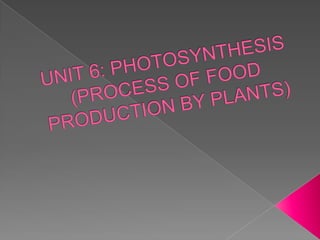
Unit 6 photosynthesis
- 2. The process that occurs in green plants, whereby solar energy is converted into chemical energy and stored as organic molecules by making use of carbon dioxide, sunlight, and water. Water and Oxygen are formed as byproducts Photosynthesis can be summarized in the following equation: 6 CO2 + 12 H2O + Light energy C6H12O6 + 6 O2 + 6 H2O (glucose)
- 3. Photoautotrophs can photosynthesize. Include: Green plants, algae, cyanobacteria and green protists. Plants Green protists Algae Cyanobacteria
- 4. To provide nutrients and oxygen for heterotrophs. Heterotrophs are dependent on autotrophs, because they cannot produce there own food.
- 5. Photosynthesis occurs in the chloroplasts of plant cells. The chloroplasts are mainly concentrated in the mesophyll cells of leaves. Chloroplast contain chlorophyll – green pigment that absorbs sunlight. Chlorophyll fill the space in the thylakoid membrane.
- 6. CHLOROPLAST MESOPHYLL CELL (PALLISADE AND SPONGY)
- 7. Chloroplast Outer membrane Thylakoid Intermembrane Stroma Granum Thylakoid space space Inner membrane 1 µm
- 8. • The raw materials of photosynthesis are: water, carbon dioxide and sunlight.
- 9. Water is absorbed through the root hair into the xylem of the roots, into the xylem of the stem, through the xylem of the leaves into the mesophyll cells and finally into the chloroplasts. Carbon dioxide diffuses from the atmosphere through the stomata, into the intercellular airspaces in the leaves, and finally into the chloroplasts of the mesophyll cells. The chlorophyll and other pigments in the thylakoid membrane absorb the solar energy to drive photosynthesis
- 10. LIGHT REACTION PHASE (Dependent on light) DARK PHASE/ CALVIN CYCLE (Light independent)
- 11. Takes place in the thylakoids of the chloroplasts. Chlorophyll absorbs solar energy from the sun. When a chlorophyll pigment absorbs light energy, it excites the electrons, which goes from ground state to an excited state, which is unstable, but can be used as potential energy. When unused excited e- fall back to the ground state, and heat are given off.
- 12. The electrons are excited in the photosystems fount in the thylakoid membrane This potential energy is then used firstly to split water – into hydrogen & oxygen. 2H2O 2H2 + O2 Oxygen is released as a byproduct – diffuse through stomata into atmosphere. The hydrogen reduces NADP+ to NADPH Some energy is then used to photophosphorylate ADP to generate ATP. ADP + P ATP
- 13. Fig. 10-5-2 H2O Light NADP+ ADP + P i Light Reactions ATP NADPH Chloroplast O2
- 14. Carbon dioxide diffuses through the stomata of the leave and finally into the stroma of the chloroplast. The carbon dioxide is accepted by a 5C molecule called ribulose biphosphate (RuBP) which then forms an unstable 6C compound. 6C compound dissociates into 2 x 3C compounds called phosphoglycerate (PGA)
- 15. PGA is then reduced to phosphoglyceraldehyde (PGAL/ G3P) by accepting a phosphate from ATP and a hydrogen electron from NADPH. Thus changing ATP back to ADP and NADPH to NADP. PGAL are now used for the following reactions: Some PGAL are used to make RuBP again, so that the cycle can start over again. Some PGAL are used to form hexose sugars like glucose and fructose. Which combine to form disaccharides and polysaccharides. * The carbohydrates can then be converted to other biological compounds like proteins or fats by adding mineral salts like nitrates and phoshates.
- 16. CO2 + RuBP(5C) 6C compound 2x PGA (3C) PGAL ATP = ADP + P NADPH = NADP + H
- 17. Fig. 10-21 H2O CO2 Light NADP+ ADP + P i Light RuBP Reactions: 3-Phosphoglycerate Photosystem II Calvin Electron transport chain Cycle Photosystem I Electron transport chain ATP G3P Starch NADPH (storage) Chloroplast O2 Sucrose (export) .
- 18. Light is a form of energy = ELECTROMAGNETIC ENERGY/ ELECTROMAGNETIC RADIATION The electromagnetic energy travel in waves. Distance between crests of electromagnetic waves = WAVELENGTH Wavelength range from ≤ 1nm (gamma rays) – ≥ 1 km (radio waves) The entire range of radiation wavelengths = ELECTROMAGNETIC SPECTRUM
- 20. Fig. 10-6 1m 10–5 nm 10–3 nm 1 nm 103 nm 106 nm (109 nm) 103 m Gamma Micro- Radio X-rays UV Infrared waves waves rays Visible light 380 450 500 550 600 650 700 750 nm Shorter wavelength Longer wavelength Higher energy Lower energy
- 21. The most important part for life is the visible light (380nm – 750nm) We can see this light as various colours. Light consist of particles = PHOTONS Photons have energy- The shorter the wave length the greater the energy of the photon. Therefore violet light has more energy than red light. Photosynthesis are driven by visible light of the sun.
- 22. Chlorophyll a – Absorb violet, blue and red light. Reflects and transmits green light (that is why plant leaves appear green) Chlorophyll b – Absorb violet, blue and red light. Reflects and transmits green light (that is why plant leaves appear green). Carotenoids – Play an accessory role in photosynthesis. They are shades of yellow and orange and able to absorb light in the violet- blue-green range. These pigments become noticeable in the fall when chlorophyll breaks down.
- 23. The thylakoid membrane of a chroloplast contains several photosystems. A photosystem consist of a protein complex called a reaction-centre complex surrounded by several light harvesting complexes. Study the diagram to understand the process of light harvesting.
- 24. Photosystem STROMA Photon Primary Light-harvesting Reaction-center electron complexes complex acceptor Thylakoid membrane e– Transfer Special pair of Pigment of energy chlorophyll a molecules molecules THYLAKOID SPACE (INTERIOR OF THYLAKOID)
- 25. Energy entering chloroplasts as sunlight gets stored as chemical energy in organic compounds Sugar made in the chloroplasts supplies chemical energy and carbon skeletons to synthesize the organic molecules of cells. Plants store excess sugar as starch in structures such as roots, tubers, seeds, and fruits In addition to food production, photosynthesis produces the O2 in our atmosphere